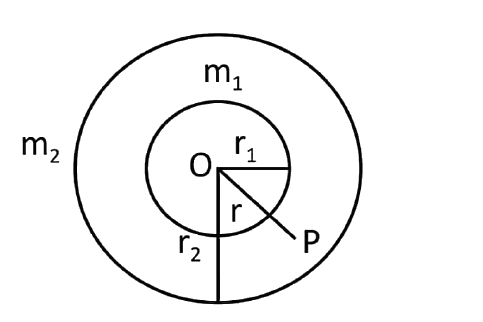Two spherical bodies of mass M and 5M & radii R & 2R respectively are released in free space with initial separation between their centres equal to 12R. If they attract each other due to gravitational force only, then the distance covered by the smallar body just before collision is
The correct Answer is:C
To solve the problem, we need to determine the distance covered by the smaller body (mass M) just before collision with the larger body (mass 5M). Here’s a step-by-step solution:
Step 1: Understand the system
We have two spherical bodies:
- Body 1: Mass = M, Radius = R
- Body 2: Mass = 5M, Radius = 2R
The initial separation between their centers is given as 12R.
Step 2: Define the distances traveled
Let:
- x1 = distance traveled by the smaller body (mass M) before collision
- x2 = distance traveled by the larger body (mass 5M) before collision
Step 3: Apply conservation of momentum
Since there are no external forces acting on the system, the total momentum is conserved. Initially, both bodies are at rest, so the initial momentum is zero.
The final momentum can be expressed as:
0=M⋅v1−5M⋅v2
Where v1 and v2 are the velocities of the smaller and larger body, respectively.
Step 4: Relate velocities to distances
The velocities can be expressed in terms of the distances traveled:
- v1=x1t
- v2=x2t
Substituting these into the momentum equation gives:
0=M⋅(x1t)−5M⋅(x2t)
Cancelling M and t (since they are not zero) results in:
x1=5x2
(Equation 1)
Step 5: Apply the distance condition
The total distance covered by both bodies before they collide is equal to the initial separation minus the sum of their radii:
x1+x2=12R−(R+2R)=12R−3R=9R
(Equation 2)
Step 6: Substitute Equation 1 into Equation 2
Substituting x1=5x2 into Equation 2:
5x2+x2=9R
This simplifies to:
6x2=9R
Thus,
x2=9R6=1.5R
Step 7: Find x1
Now substituting x2 back into Equation 1 to find x1:
x1=5x2=5⋅1.5R=7.5R
Final Answer
The distance covered by the smaller body just before collision is:
7.5R
We have two spherical bodies:
- Body 1: Mass = M, Radius = R
- Body 2: Mass = 5M, Radius = 2R
Let:
- x1 = distance traveled by the smaller body (mass M) before collision
- x2 = distance traveled by the larger body (mass 5M) before collision
Since there are no external forces acting on the system, the total momentum is conserved. Initially, both bodies are at rest, so the initial momentum is zero.
0=M⋅v1−5M⋅v2
Where v1 and v2 are the velocities of the smaller and larger body, respectively.
The velocities can be expressed in terms of the distances traveled:
- v1=x1t
- v2=x2t
0=M⋅(x1t)−5M⋅(x2t)
Cancelling M and t (since they are not zero) results in:
x1=5x2
(Equation 1)
The total distance covered by both bodies before they collide is equal to the initial separation minus the sum of their radii:
x1+x2=12R−(R+2R)=12R−3R=9R
(Equation 2)
Substituting x1=5x2 into Equation 2:
5x2+x2=9R
This simplifies to:
6x2=9R
Thus,
x2=9R6=1.5R
Now substituting x2 back into Equation 1 to find x1:
x1=5x2=5⋅1.5R=7.5R
The distance covered by the smaller body just before collision is:
7.5R
Similar Questions
Two spherical bodies of masses m and 5m and radii R and 2R respectively, are released in free space with initial separation between their centres equal to 12 R. If they attract each other due to gravitational force only, the distance covered by smaller sphere just before collision is
View SolutionTwo spherical bodies of masses m and 6m and radii R and 2R respectively are released in free space with initial separation between their centres equal to 10 R . If they attract each other due to gravitational force only , then the distance covered by smaller sphere just before collisions will be
View Solution
Knowledge Check
Two spheres each of mass M and radius R are separated by a distance of r. The gravitational potential at the midpoint of the line joining the centres of the spheres is
A−GMrB−2GMrC−GM2rD−4GMr
Two spherical bodies of masses 2M and M and radii 3R and R respectively are held at a distance 16R from each other in free space. When they are released they start approaching each other due to the gravitational force of attraction , then find
(a) the ratio of their accelerations during their motion
(b) their velocitites at the time of impact.

View SolutionTwo spheres each of mass M and radius R are separated by a distance of r. The gravitational potential at the midpoint of the line joining the centres of the spheres is
View SolutionTwo spherical balls of mass 10 kg each are placed 100 m apart. Find the gravitational force of attraction between them.
View SolutionTwo concentric shells have masses M and m and their radii are R and r, respectively, where R>r. What is the gravitational potential at their common centre?
View SolutionTwo concentric spherical shells of masses and radii m1,r1andm2,r2 respectively are as shown. The gravitational field intensity at point P is

View SolutionTwo objects of masses m and 4m are at rest at an infinite separation. They move towards each other under mutual gravitational attraction. If G is the universal gravitaitonal constant, then at separation r
View SolutionTwo spherical bodies of mass m1 & m2 are having radius 1 m & 2 m respectively. The gravitational field of the two bodies with their radial distance is shown below. The value of m1m2 is
 -
-
View Solution
